
| |
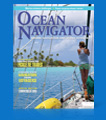 |
Hot Off The Press!
Catherine graces
the May/June cover of
Ocean Navigator magazine
|
 |
Sailing Aviators
Even at sea level, our new
Mavericks deliver the highest
clarity. Mahalo nui, Maui Jim!
|
|

| May 26, 2018 | Hope Island, Great Barrier Reef - Kite surfing with a 12 meter between squalls delivering 28 knots of wind. |
|

|
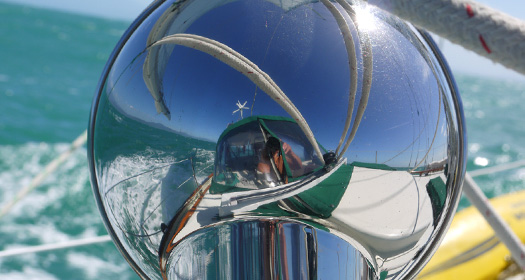
|
May 25, 2018 (Day 4,012)
Quick Fix: 16° 22.8 S / 145° 33.8 E
Conditions: Wind: 25/SE Sky: Clear

High Winds
It's tradewind season and a chain of high pressure systems, colossal vortexes of air spanning the entire width of Australia, are rolling across our latitudes and delivering, week after week, a steady 25-30 knots of southeasterly wind. As the Aussies would say, "Mate, it'll blow the cheese off yer cracka!" We're riding them north under just a reefed mainsail in the most satisfactory fashion, surfing down waves at 9 knots as we soar up the Great Barrier. We've taken respite in the Low Isles, a tiny cluster of reefs and islands that offer a calm anchorage, turtles, a few black tip sharks and three giant remora (sucker fish) that seem attached to Dream Time's hull. Tomorrow we'll fly north to Hope Island which lays just 20 nautical miles from Cooktown - eastern Australia's most remote northerly outpost. It's got a wild west reputation and travel guides advise: "It's tough country up here, exercise reasonable caution." Not entirely sure what that means: crocodiles? marauding outlaws? - but we're going to find out. |
|

| May 24, 2018 | Low Isles, Great Barrier Reef - Captain Cook wasn't very impressed when he named these low isles in 1770, but we rather like it here. |
|

|
| |

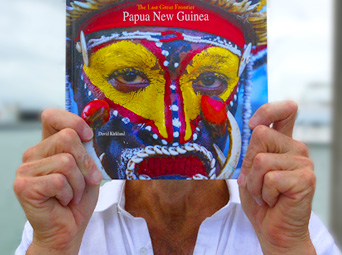
Visit David Kirkland's website to view more of his amazing photography > |
|
|
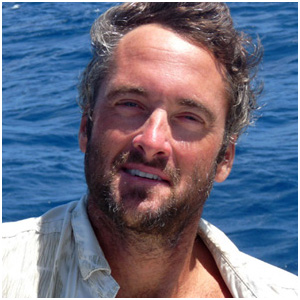 |
Day 4,006 - Cairns, Australia
23:13 hrs - May 19, 2018
Hiding in Papua New Guinea |

It's not every day you find yourself unexpectedly marooned for the night in one of the world's most dangerous cities. And then, upon your return home, only narrowly escaping immediate deportation from the country where you not only hold valid tourist visas, but also where your boat is anchored.
It's been an exciting week for the crew of Dream Time. On Tuesday we boarded Air Niugini for our scheduled flight over to Papua New Guinea for the day, a trip we had booked in March to renew our three month Australian tourist visas. Just 453 nautical miles north of Cairns it promised to be a convenient and quick day trip with a four hour layover in Port Moresby - just long enough to visit the country's National Museum & Art Gallery and perhaps mail a few postcards. But after our short 80-minute flight the immigration officer at PNG's Jacksons International Airport, after reviewing our return itinerary, casually mentioned there was no flight scheduled that afternoon back to Cairns. Ignoring our protests and wide-eyed panic stricken stares, she offered a sympathetic shrug, happily granted us a 60 day visa, welcomed us warmly to the country and waved us through to the arrival lounge.
The Air Niugini service desk reacted with much the same casual indifference. Confirming that the flight we had booked and paid for weeks in advance has actually not been in service since March. Our flight confirmation emails, the flight number, even our conversation the previous night with a booking agent to check the schedule, didn't seem to make an impression or raise any concerns. It seems the airline simply forgot to notify travel agents and booking websites about their schedule change. (Note to travelers: If you're flying from PNG avoid flight PX98 from Port Moresby to Cairns). Interesting side note: Online booking websites showed flight PX98 departing Port Moresby as scheduled and remarkably arriving in Cairns on time!
So now we're stranded in Port Moresby for the night, a city that regularly ranks as one of the most dangerous in the world and has a Livability Index rating of 136 out of 140 countries - that's not good. Indeed, according to Numbeo.com, PNG has an unsettling crime index of 83.59 (100 is the worst, which I believe represents certain death). During daylight hours Port Moresby's level of safety for walking city streets rates a dismal 24.26, which plummets further to just 13.24 after dark. This is not a place to buy a timeshare or take romantic moonlit strolls along Ela Beach. In fact, we didn't meet any other tourists during our stay, only burly khaki-wearing mining contractors from Australia and New Zealand.
Unemployment is high, and for a capital city with a population of just 350,000 to rate so poorly, well, let's just say the criminals elements must be pretty busy. Theft, assault, murders and auto theft occur on a daily basis according to one travel-watch website, public transportation should be avoided by visitors at all cost, and if that's not enough to dissuade you from booking a flight today, the entire region is tormented by seismic activity, cyclones, landslides and tsunamis. Drugs are a problem, too, and the streets are literally splattered in red - not blood! - but rather the mustard laced betel nut discharge that many locals chew with toothless abandon and flob in paint ball-size splats on the streets.
After a few calls from the airport we had a room booked in downtown Port Moresby, and with daylight hours considered to be the safest we decided to make the most of our adventure and visit the National Museum. We hailed a cab, excited, a little nervous, but embracing the spontaneity of our day. We planned to spend the whole afternoon touring the Museum to learn all we could about PNG's tumultuous history, its people, culture and art in air conditioned safety. We arrived only to find it closed for renovation - even though a sign pinned to the chain link fence indicated it would reopen in April.
Another half an hour and 70 Kina later (about $20) we were in downtown Port Moresby, a rather dusty and congested place, it felt like a lawless frontier town, and we immediately liked it. It reminded us of our time exploring Fronteras in Guatemala, the back streets of Port Vila in Vanuatu and Pago Pago in American Samoa - gritty, sweaty, an undertone of danger- an exciting tropical city unknown to most of the world.
We checked in to the hotel (we didn't have a single bag to unpack) and with daylight hours waning we set off to find the local post office. When hearing of our plans the hotel immediately put a stop to our folly and assigned a member of their staff to act as our personal security detail. Apparently, even with the sun still high, tourists are safer when accompanied by a local. Raymonde, a solid man with a large head that was mostly smile, quickly changed from his hotel-branded shirt to civilian attire, presumably not to draw too much attention to where he worked and the fact that the hotel was quite possibly housing the only two tourists in town. A gate within the guarded perimeter barricade surrounding the hotel grounds was unlocked, and we stepped out onto the street.
Local eyes seemed to follow us intently down every sidewalk but with Raymonde as our guide, only one vendor dared to engage - a scrappy lad of about 10 years old who Raymonde blocked with a forceful stare and a dismissive "SSSHHHH", much like the dog whisperer reprimanding a boisterous pup. We continued unmolested.
The post office was an original building from the glorious colonial era which, according to Raymonde, the city has fought to preserve. There were only two dusty postcard designs for sale, we were the only customers in the shop, and the young girls working behind the counter giggled at absolutely every question and request: "Do you have any postcards for sale?" - Giggle! "These two designs are really awful, no wonder no tourists visit this city. May we have 10 please?" - Giggle!! "Stamps might be a good idea, too" - Giggle!!!
Perhaps it was because Raymonde was escorting us, but we felt entirely safe and comfortable walking the streets of Port Moresby, and we really wanted to explore more - to wander aimlessly around the city and chew a little betel nut with the locals. But time would not allow, Raymonde had to get back to work and the sun was getting dangerously low - it felt a little like we were in a zombie movie and had to run back to the sanctuary of our compound before the ghouls of the night came out to feed. Remarkably, by the end of the afternoon, Catherine, who has always maintained a very sensible fear of cruising PNG waters, similar to her anxiety before we sailed into Havana, suggested that perhaps we should sail Dream Time to the region after-all.
Papua New Guinea, known as The Last Great Frontier, would truly be a fascinating country to explore under sail and would offer a rare window back in time to a land and culture steeped in magic and mythology. The tribal ceremonies, ancient tropical jungles, unsurveyed coastlines with countless reefs and islands, it is a place where true cruising adventures are made. Sure, PNG has had its share of troubles like many countries in the western Pacific or Southeast Asia, so caution should be exercised. But our brief and unexpected stay left us wanting to see much, much more, not less.
Our return flight to Cairns the next day was quick and uneventful and it was not without a measure of relief to find ourselves back in Australian territory, that is, until we arrived at the immigration kiosk. Catherine waltzed through without issue, but my passport scan was denied with a screen message instructing me to speak to an officer. About this time I noticed a serious looking chap approach the immigration desk, and behind folded arms seemed to be waiting for something important to happen.
The lady at the immigration booth scanned my passport, frowned, and asked how long I intended to be in the country and the purpose of my visit. "No more than three months" I said, "and I'm here on holiday." This, apparently, was either not a reasonable or believable answer. My passport exchanged efficiently from her hands to the serious chap waiting behind who, I discovered, was there especially to see me.
Paul, the immigration officer, was a amiable fellow, but over the next thirty minutes questioned Catherine and I extensively about our journey, our careers, our finances and our suspicious travel patterns. It seems, even though we have adhered to our visa regulations (our one year visa allows multiple entries into Australia for a maximum stay of up to three months per visit) departing the country for one day, even though legally acceptable, 'raised serious alarms'. Paul continued to say that we were suspected of working illegally and that Australia would have every right to put us on the first plane back to England!
Thank goodness we've maintained this website which chronicles our travel patterns and behavior - without it, it is quite possible we may never have seen Dream Time again. |

| May 16, 2018 | Port Moresby, Papua New Guinea - Sunrise over Walter Bay - from the safety of our hotel room. |
|

|
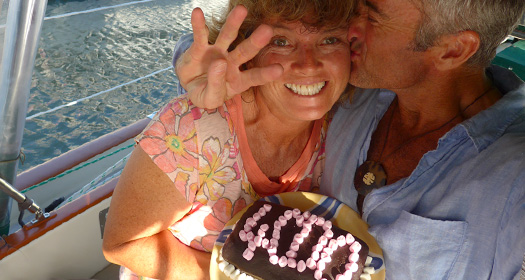
|
May 13, 2018 (Day 4,000)
Quick Fix: 16° 55.0 S / 145° 46.9 E
Conditions: Wind: 25/SE Sky: Clear

4,000 Days to Cairns!
As the crow flies, it’s about 9,562 miles from New York to Cairns in Australia, and according to travelmath.com that should takes 19 hours and 37 minutes of flight time, although not crow flying time, I’m guessing that’s a whole other calculation. But if you’re not in a hurry, and you like wind and moving all the time you can sail it. I think we’re definitely at the slower end of the scale as far as sailing goes as it’s taken us 4,000 days to get here, but we still got here and that feels like cause for celebration, cake style!
Living this kind of slow motion existence has convinced us to see this life as a journey. Our destinations come and go, but the journey continues. We still have a really long way to go, makes me wonder what the next 4,000 days will bring? And where will it take us? - CH |
|

|
 |

|

| May 10, 2018 | All quiet onboard. A brilliant sunset behind Mac Allister Range. Dream Time gliding north under full sail, getting ready for the first night watch. |
|

|
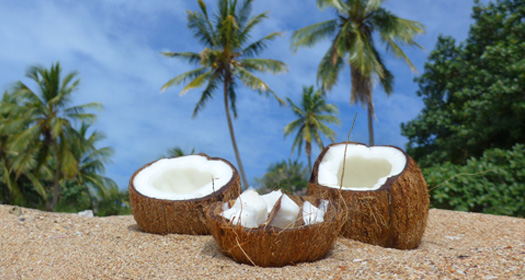
|
May 8, 2018 (Day 3,995)
Quick Fix: 19° 06.7 S / 146° 51.5 E
Conditions: Wind: 15/SE Sky: Mostly clear

Beach Tucker
Tomorrow we'll continue to trace Captain Cook's wake up the coast of Australia. We'll stop in Cairns to provision before sailing on to Lizard Island where we'll climb the historic Cooks Look - the 1,100 foot summit where Cook stood in 1770 to seek a safe passage through the Great Barrier Reef. Our sail to Cairns will be a mellow, 150 nautical mile, overnight passage with a forecast promising 15 knots of southeasterly wind, clear skies and just three foot seas - perfect. We spent our last day on Magnetic Island with a hike to Radical Bay, a delightfully secluded cove complete with towering coconut palms. Employing skills acquired in Polynesia we had a couple of coconuts opened in a jiffy using a snapped branch to remove the husk and a small rock to crack the top. The coconut lids became bowls to hold the meat, while the rest of the nut served as mugs - pre-filled with delicious coconut water. What we didn't eat we left for the tropical birds to enjoy. |
|

|

| May 7, 2018 | Magnetic Island - Just a 'moderate' stinger threat today, so unless you're pregnant, young, old, or suffer from high blood pressure, enjoy! |
|
| |


|
|
|
 |
Day 3,992 - Magnetic Island, Australia
19:02 hrs - May 5, 2018
Magnetic Maggie |

In 1770 Captain Cook sailed up the east coast of Australia and observed, as the Endeavor past an island in a region that would later be known as the Great Barrier Reef, that the needle on the ship's compass went a little erratic. Noting the mysterious anomaly in the ship's log he named the island Magnetic and continued north. (Interesting fact: Just two hundred nautical miles later the Endeavor struck a reef and was almost lost to the sea - coincidence? I'll let you decide.)
Anyway, with Australian's penchant for efficiency, Magnetic Island has since been shortened to 'Maggie' and its cool, casual, quirky vibe now attracts a steady stream of tourists and backpackers looking for a little tropical paradise. Around 2,000 locals live on Maggie, their homes hidden away in the shelter of sandy coves and amongst giant natural rock gardens, swaying pines and eucalyptus trees where, if you take the time to look, you'll probably sight a koala or two lounging in the canopies.
The koalas were introduced to Maggie in 1932, and they seem to like it here, too. Although signs are posted around the island depicting, what seems to me, like an angry albino koala giving you the finger, or claw, as the case may be. A warning, perhaps, to the speedy scooter-riding backpackers or Jurassic Park-style jeep explorers zooming around the island's one road to keep their speed under 60 kph.
The single paved road meanders along just one side of the downward pointing triangular island and is a little over six miles in length from Horseshoe Bay to the north, to Picnic Bay on the island's southern tip. Our rental company, for an 'island price' of $100 a day, offered 'unlimited mileage' and a 'free tank of gas' with our red jeep. But even after three laps around Maggie and searching every side road for fallen coconuts (we collected twelve) we still traveled less than thirty miles over the course of the day and returned the jeep with almost a full tank.
But Maggie is not a place to race around, it's island time here, so days drift slowly past like the occasional cloud (Maggie boasts 320 days of sunshine a year), backpackers gather for the full moon parties and regular tourists seem entirely content to spend their days floating in the warm waters of one of the many perfect bays around the shoreline - although, as it's still jelly fish season, that means within the confines of a stinger net.
Box jelly fish and irukandji trawl their deadly tentacles through these northern waters from November to May. Stings, while rarely fatal, will certainly ruin your mellow island vibe, so most beaches post warnings, daily threat levels, and even containers of vinegar along the shoreline to dowse an effected appendage. Locals claim the stinger nets will be removed next week so swimmers and snorkelers will be free to explore open water without wearing a full body stinger suit. The yellow buoys that bob a little further off the shoreline, however, will remain. These, according to a lifeguard patrolling Alma Bay, mark where the sharks like to feed. But really, stinger and shark attacks are very rare and for the most part can be easily avoided. The biggest threat to tourists is sunburn.
In two days we'll raise the hook and climb three more latitudes to Cairns, the gateway to Queensland's remote tropical north. It'll be an easy overnight passage, just 150 nautical miles with a forecast that's promising following tradewinds and the calm seas you can expect inside the reef. We'd like to stay in Maggie a little longer, but it's time we tear ourselves away from this little island paradise and continue following in Cook's wake, up the Great Barrier Reef, over the top and into new northern territory. |

| May 5, 2018 | A Maggie rock garden. |
|

|
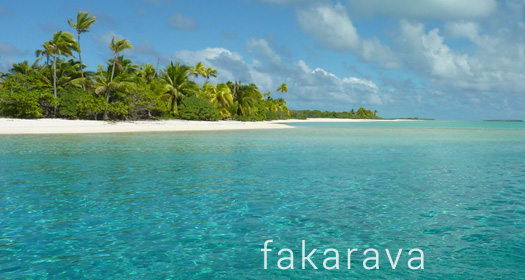
|
May 1, 2018 (Day 3,988)
Quick Fix: 19° 15.1 S / 146° 49.4 E
Conditions: Wind: 15/ESE Sky: Clear

The World's Best Beach
We recently visited 'Australia's Best Beach' - 98% silica sand so fine it squeaks like a tiny chew toy under every barefoot step and, according to officials, it also rates the fourth best in the world. Indeed, Whitehaven Beach in the Whitsundays is a beautiful stretch of sand, but after 11 years of cruising we've compiled a list of some of our favorites. Beaches where you won't find, for example, a helicopter and sea planes perched on the shorelines with crowds of selfie stick swinging tourists. If you're seeking the truly remote sun-drenched corners of the world, the real castaway experience with pure untrampled sandy shorelines, where bikinis and board shorts are always optional, beach fires are almost compulsory, and palm trees rustle in the tradewinds (yes, it absolutely has to have palm trees!), and a blissfully calm secure anchorage in the lee, well, below are a few Dream Time recommendations: |
|

|
 |

| Fakarava - This is as good as it can possibly get. |
|

| Tahanea - A very close second. |
|
|
|

 |
|

